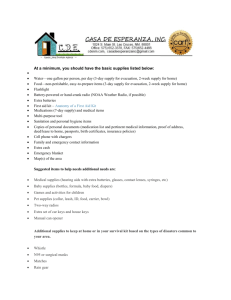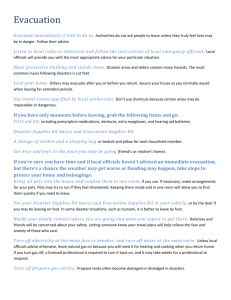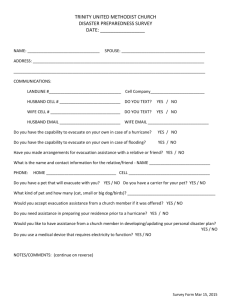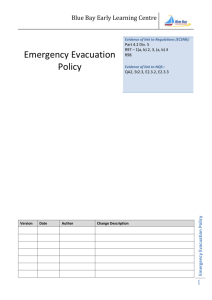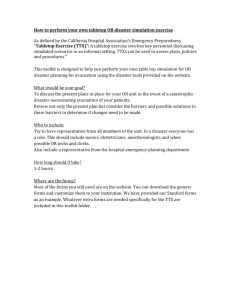Evacuation Plan RedCross - Casa de Esperanza Las Cruces
advertisement
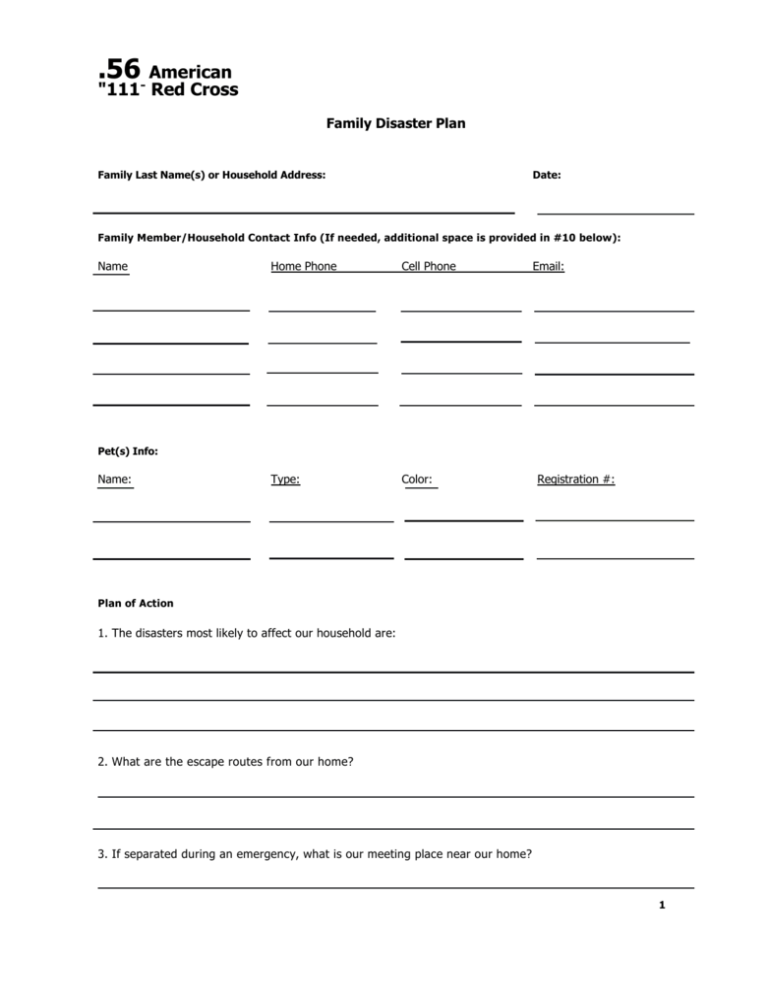
.56- American "111 Red Cross Family Disaster Plan Family Last Name(s) or Household Address: Date: Family Member/Household Contact Info (If needed, additional space is provided in #10 below): Name Home Phone Cell Phone Type: Color: Email: Pet(s) Info: Name: Registration #: Plan of Action 1. The disasters most likely to affect our household are: 2. What are the escape routes from our home? 3. If separated during an emergency, what is our meeting place near our home? 1 4. If we cannot return home or are asked to evacuate, what is our meeting place outside of our neighborhood? What is our route to get there and an alternate route, if the first route is impassible? 5. In the event our household is separated or unable to communicate with each other, our emergency contact outside of our immediate area is: Name Home Phone Cell Phone Email: After a disaster, let your friends and family know you are okay by registering at "Safe and Well" at https://safeandwell.communitvos.orecmsl/ or by calling 1-800-733-2767. You can also give them a call, send a quick text or update your status on social networking sites. 6. If at school/daycare, our child(ren) will be evacuated to: Child's Name: Evacuation Site (address and contact info): 7. Our plan for people in our household with a disability or special need is: Person's Name: Plan: 8. During certain emergencies local authorities may direct us to "shelter in place" in our home. An accessible, safe room where we can go, seal windows, vents and doors and listen to emergency broadcasts for instructions, is: 2 9. Family Member Responsibilities in the Event of a Disaster Description Task Disaster Kit* Stock the disaster kit and take it if evacuation is necessary. Include items you might want to take to an evacuation shelter. Remember to include medications and eye glasses. Be informed Maintain access to NOAA or local radio, TV, email or text alerts for Family Member Responsible important and current information about disasters. Family Make sure the household medical information is taken with us if Medical evacuation is necessary. Information Financial Information Obtain copies of bank statements and cash in the event ATMs and credit cards do not work due to power outages. Bring copies of utility bills as proof of residence in applying for assistance. Pet Information Evacuate our pet(s), keep a phone list of pet-friendly motels and animal shelters, and assemble and take the pet disaster kit. Sharing and Share the completed plan with those who need to know. Meet with Maintaining household members every 6 months or as needs change to update the Plan household plan. *What supplies and records should go in your disaster kit? Visit www.redcross.ora 10. Other information, if not able to be included above. Congratulations on completing your family disaster plan/ Please tell others: "We've made a family disaster plan and you can, too, with help from the American Red Cross." Get the facts about what you should do if an emergency or disaster occurs at www.redcross.org 3 At a minimum, you should have the basic supplies listed below: Water—one gallon per person, per day (3-day supply for evacuation, 2-week supply for home) Food—non-perishable, easy-to-prepare items (3-day supply for evacuation, 2-week supply for home) Flashlight Battery-powered or hand-crank radio (NOAA Weather Radio, if possible) Extra batteries First aid kit — Anatomy of a First Aid Kit Medications (7-day supply) and medical items Multi-purpose tool Sanitation and personal hygiene items Copies of personal documents (medication list and pertinent medical information, proo f of address, deed/lease to home, passports, birth certificates, insurance policies) Cell phone with chargers Family and emergency contact information Extra cash Emergency blanket Map(s) of the area Suggested items to help needs additional needs are: Medical supplies (hearing aids with extra batteries, glasses, contact lenses, syringes, etc.) Baby supplies (bottles, formula, baby food, diapers) Games and activities for children Pet supplies (collar, leash. ID, food, carrier, bowl) Two-way radios Extra set of car keys and house keys Manual can opener Additional supplies to keep at home or in your survival kit based on the types of disasters common to your area. Whistle N95 or surgical masks Matches Rain gear Towels Work gloves Tools/supplies for securing your home Extra clothing, hat and sturdy shoes Plastic sheeting Duct tape Scissors Household liquid bleach Entertainment items Blankets or sleeping bags Plan what to do in case you are separated during an emergency Choose two places to meet: — Right outside your home in case of a sudden emergency, such as a fire — Outside your neighborhood, in case you cannot return home or are asked to evacuate Choose an out-of-area emergency contact person. It may be easier to text or call long distance if local phone lines are overloaded or out of service. Everyone should have emergency contact information in writing or saved on their cell phones. Plan what to do if you have to evacuate Decide where you would go and what route you would take to get there. You may choose to go to a hotel/motel, stay with friends or relatives in a safe location or go to an evacuation shelter if necessary. Practice evacuating your home twice a year. Drive your planned evacuation route and plot alternate routes on your map in case roads are impassable. Plan ahead for your pets. Keep a phone list of pet-friendly hotels/motels and animal shelters that are along your evacuation routes. Let Your Family Know You're Safe If your community has experienced a disaster, register on the American Red Cross Safe and Well Nkebsite to let your family and friends know you are safe. You may also call 1-800-RED CROSS (1800733-2767) and select the prompt for "Disaster" to register yourself and your family. Be Informed Know Important Information to Stay Safe Learn the types of disasters or emergencies that may likely occur in your area. These events can range from those affecting only you and your family, like a home fire or medical emergency, to those affecting your entire community, like an earthquake or flood. Identify how local authorities will notify you during a disaster and how you will get information, whether through local radio, TV or NOAA Weather Radio stations or channels. Know the difference between different weather alerts such as watches and warnings and what actions to take in each. Know what actions to take to protect yourself during disasters that may occur in areas where you travel or have moved recently. For example, if you travel to a place where earthquakes are common and you are not familiar with them, make sure you know what to do to protect yourself should one occur. When a major disaster occurs, your community can change in an instant. Loved ones may be hurt and emergency response is likely to be delayed. Make sure that at least one member of your household is trained in first aid and CPR and knows how to use an automated external defibrillator (AED). This training is useful in many emergency situations. Share what you have learned with your family, household and neighbors and encourage them to be informed. Emergency Contact Cards for All Household Members Print one card for each family member. Write the contact information for each household member, such as work, school and cell phone numbers. Fold the card so it fits in your pocket, wallet or purse. Carry the card with you so it is available in the event of a disaster or other emergency. CASA DE ESPERANZA, INC. POLICIES AND PROCEDURES SECTION: 500 EMERGENCY PROCEDURE & RESPONSE POLICY: 502.01 EMERGENCY FIRE, BOMB THREATS, NATURAL DISASTER PROCEDURE AND RESPONSES POLICY: CDE, Inc. maintains a recommended procedure to provide emergency preparedness/ disaster planning to protect the safety and well being of individuals served and staff by CDE, Inc. contracted staff will receive this information. PROCEDURES: I. CDE Inc. staff, employed or contracted, will receive this information during the initial orientation and yearly thereafter. 2. CDE, Inc. staff, employed or contracted, will review the FEMA/American Red Cross "Preparing for a Disaster" document during initial orientation training. 3. Planning Information: CDE, Inc. recommends the following strategies for planning in reference to emergency evacuation: a. b. c. d. e. f. g. h. Designate a meeting area at least 100 feet from the Family Living home that Family Members may evacuate to. Create a plan that may be implemented by all family members that list a central meeting location. Assure that medication for all family members or medical equipment (i.e. oxygen machine, durable medical equipment) may be transported upon evacuation. Create list of safe places the family may evacuate to and assure that all family members are aware of location. This list may consist of community centers, hotel/motels, other family or friend's homes, churches etc. Upon arrival at evacuation location, phone to the CDE Inc. administrative offices or agency on call to notify of evacuation and location for additional recommendations. In the instance that a family living provider is having difficulty creating a plan, CDE Inc. administrative staff will assist with planning and designation of a safe evacuation place in the community the individual is served. Please remember to stay as calm as possible during the evacuation process in order to reduce the stress levels of all individuals involved. Family Living Service Providers will evacuate to the most naturally safe area as determined by the Individual Family Living Provider. 4. FIRE: If you smell smoke or see smoke or fire: a. b. c. d. e. f. Raise the alarm. Activate the nearest fire alarm. Close room door(s) Safely exit the building Ca11911 Never attempt to fight or put out a fire Tell Fire Authorities exact location of fire or smoke. 5. Evacuating the Premises: a. b. c. d. DO NOT RUN OR SHOUT- STAY CALM! Immediately exit the building. Always assume an emergency, never assume a false alarm Use stairs, not elevators if possible. e. f. Do not open door if Knob is warm to the touch: stay in room and call 911 Crawl on floor (where air is fresher) if smoke is encountered. 6. How to use a Fire Extinguisher: 1. 2. 3. 4. 5. 6. Even though extinguishers come in a number of shapes and sizes, they all operate in a similar manner. Here is an easy acronym for fire extinguisher use: -PASS-Pull, Aim, Squeeze, and Sweep PULL- the pin at the top of the extinguisher that keeps the handle from being accidentally pressed. AIM- the nozzle toward the base of the fire. Stand approximately 8 feet away from the fire and SQUEEZE the handle to discharge the extinguisher. If you release the handle, the discharge will stop. SWEEP- the nozzle back and forth at the base of the fire. After the fire appears to be out, watch it carefully it may reignite! NATURAL DISASTER: The Desert Southwest is not prone to experience many natural disasters. In the event the following natural disasters occur please respond in a safe manner. FLOOD: During a flood emergency staff will receive instruction through television or radio emergency response system. If an evacuation order is given staff will: a. b. c. d. e. Take only essential items If there is time gas, electricity and water will be turned off Appliances will be turned off. Follow the designated evacuation routes Do not attempt to drive or walk across creeks or flooded roads. TORNADO: In the case that the National Weather Service has issued a tornado or a staff member is witness to a funnel cloud in the immediate area staff will assure individual: a. b. c. Move away from windows and glass doorways Go to innermost part of the building Protect your head and make yourself as small of a target as possible EARTHQUAKE: If an earthquake strikes, you may be able to take cover under a heavy desk or table. It can provide you with airspace if the building collapses. Inner walls or door frames are the least to collapse and may also shield against falling objects. If other cover is not available, go to an inner comer or doorway, away from windows and glass panels. Grab something to shield your head from falling debris and broken glass. Once an all clear order is given staff will be assessed for injury. a. Family Living Services provider will evacuate to the most naturally safe area as determined by the Individual Family Living Services Provider. ROADSIDE EMERGENCIES: When you are driving, things happen very quickly. You may have only a fraction of a second to make the right move. Follow these guidelines for handling emergencies: 1. Breakdowns: a. b. c. d. e. If possible, park where the disabled vehicle can been seen for 200 feet in each direction. Move the vehicle so all four wheels are off the pavement. Turn on emergency flashers. Get all passengers out on the side away from traffic. Raise the Hood. 2. Tire Blowout: a. b. c. d. e. Do not use brakes. Concentrate on steering Slow down gradually Brake softly when the car is under control Pull completely off the pavement 3. Wet Brakes: a. b. c. Test brakes lightly after driving through deep water. Brakes may pull to one side or may not hold at all. Dry brakes by driving slowly in low gear and applying brakes. 4. Car or Motorcycle Approaching in your lane: a. b. c. Sound your horn Brake sharply Steer for the side of the road or the ditch. 5. Jammed Gas Petal: a. b. c. d. e. f. Keep your eyes on the road Tap the gas pedal with your foot Try to pry the pedal up with the toe of your shoe Shift into neutral Turn off the ignition. Use the brakes. 6. Skidding: a. b. c. d. Take your foot off the gas pedal. Do not use your brakes, if possible Pump the brakes gently if your about to hit something Steer the car into the direction of the skid to straighten the vehicle out. Then steer in the direction you wish to go. BOMB THREAT: 1. In the event that bomb threat is received it is important for the person receiving the call to attempt to keep the caller on the phone as long as possible. 2. It is also important to listen carefully to all information provided by the caller and to make a note of any voice characteristics, accents, or background noises. 3. Immediately upon phone conversation ending sound fire alarm to evaluate, call 911, and evacuate to outdoor safety designated area. In the event that a suspicious package or bag is found, sound fire alarm for evacuation and dial 911. Evacuate to outdoor safety designated area and await emergency personnel. UTILITY FAILURE: 1.GAS: a. Locate your gas meter, shutoff valve and know how to turn the gas off. b.If the valve my not be working properly, call your utility company for an operational check. c. If you smell natural gas, get everyone out and away from the home immediately. DO NOT Light matches, lighters, open flames appliances or operate electrical switches. Sparks could ignite gas causing an explosion. d.Shut off the gas ONLY if you smell gas and cannot locate the leak. LET THE GAS COMPANY TURN THE GAS BACK ON. e. Seek the assistance of a plumber to repair gas pipe damages. f. All households should consider purchasing and installing a carbon monoxide detector for the home. g.Treat all gas odors seriously. Any odors may indicate a dangerous situation. 2. ELECTRICITY: a. b. c. d. e. f. Locate your main electrical switch or fuse panel and learn how to turn the electrical power off. Electrical sparks can cause a fire or explosion. If available use a generator as a backup. Make sure you know where an emergency kit is and that it is well equipped for all emergencies. Always have a plan where you would go in case of an emergency. Prearrange community resources for support. 3.WATER: a. b. c. d. e. f. g. Label the water shut-off valve and know how to turn off the home water supply. Ensure valve can be fully turned off. Shut-off the main valve to prevent contamination of the water supply in your water heater and plumbing, and to prevent home from flooding in case the pipes are damaged. Flip up the little hinged door on the meter box lid and pull the entire lid off the meter box for access to the meter valve. Carefully remove any insulation and turn the valve off. The meter valve is off when the two holes on the side of the meter valve are aligned. To turn the meter valve back on, simply turn the arrow bar in the opposite direction. A well is usually comprised of a casing, well caps. Well screens, and pit less adapters. Shutoff all electricity as well. A shut-off valve is generally located on the household supply line connected from the casing and well cap. SAFETY DURING VIOLENT OR THREATENING SITUATIONS: I. Safety during violent or threatening situations may include Explosions, gas leaks, bio-chemical threats, terrorism and weapons. 2. CDE, Inc. requires that each personnel is required to take a training on Incident Reporting, and Transportation and Safety Training. 3. Make sure you Identify possible risk factors that could be related to a facility. 4. Make sure to assess and identify with persons served. 5. Make a plan that is communicated to community resources for priority needs. 6. Be aware of safe areas and evacuation procedures. MEDICAL Emergencies 1. Call 911 2. Provide the following information a. Address b. Caller's name and phone number c. Nature of injury and severity of the injury d. Location of injured person e. Age of injured person f. Sex of injured person g. Current condition h. Any known medical history 3. Remain with the person with the medical injury. DO NOT move them unless they are in immediate danger of further injury. MOBILITY-IMPAIRED - WHEELCHAIR In most buildings, people will need to use stairwells to reach building exits. Elevators cannot be used because they have been shown to be unsafe in an emergency. Persons in wheelchairs located on the first floor, may use building exits to the outside ground level. For disabled individuals on upper floors, it is not safe to attempt to move a wheelchair down the stairs. One effective approach to the situation is the following: STAY IN PLACE While working with an evacuation assistant, select a room with an exterior window, a telephone and a solid or fire-resistant door. Remain with the disabled person in this room, and send someone to the evacuation assembly area to notify emergency personnel of the location of the person needing assistance. It is also possible to place the person needing assistance near a stairway landing to await assistance, although this area may not be protected from smoke and other hazards. Fire Department personnel, who are trained in emergency rescue, can then enter the building and assist the person in exiting the building, either down the stairs or using the emergency elevator recall. Stairwell evacuation of wheelchair users should be conducted by trained professionals from emergency services. Only in situations of extreme danger should untrained people attempt to evacuate wheelchair users. If this must be attempted, one possibility is the following. MOBILITY IMPAIRED- NON-WHEELCHAIR Persons with mobility impairments who are able to walk independently should be able to negotiate stairs in an emergency with minor assistance. The individual should wait until the heavy traffic has cleared on the stairwell before attempting to exit. There should be at least one evacuation assistant with the challenged individual to assist if needed. HEARING IMPAIRED Some buildings on campus are equipped with fire strobe lights; however, some are not. Persons with hearing impairments may not hear audio alarms and will need to be alerted to emergency situations by an evacuation assistant. VISUALLY IMPAIRED Most people with visual impairments will be familiar with their immediate surroundings and frequently traveled routes. Since the emergency evacuation route may be different from the commonly traveled route, persons who are visually impaired may need assistance in evacuation. The evacuation assistant should offer his/her elbow to the individual with the visual impairment and guide him/her through the evacuation route. During the evacuation, the evacuation assistant should communicate as necessary to ensure safe evacuation. Building emergency response staff should assess the needs of any building occupants with special needs within their zone before an emergency. Ask if there are any staff or faculty members, who require special assistance in the event of an evacuation, and arrange for nearby individuals to serve as evacuation assistants.
